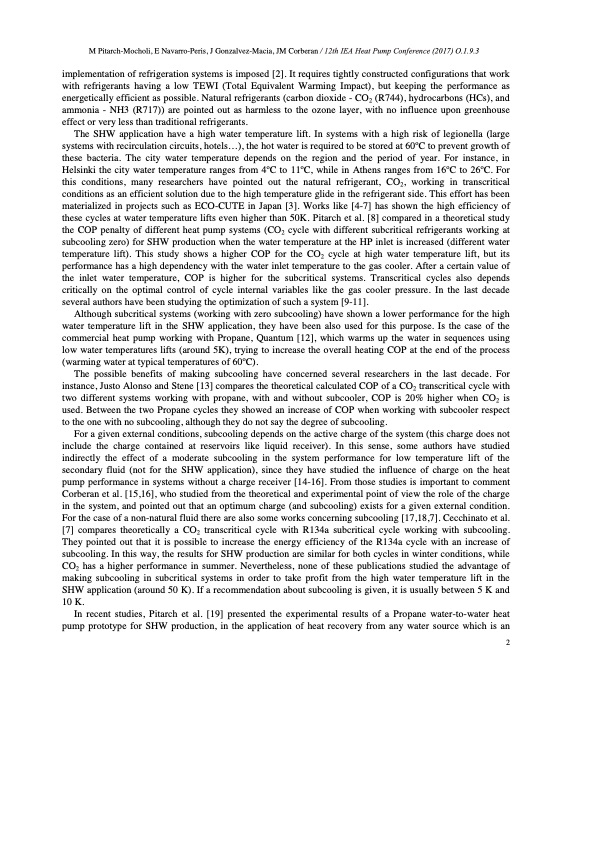
PDF Publication Title:
Text from PDF Page: 002
M Pitarch-Mocholi, E Navarro-Peris, J Gonzalvez-Macia, JM Corberan / 12th IEA Heat Pump Conference (2017) O.1.9.3 implementation of refrigeration systems is imposed [2]. It requires tightly constructed configurations that work with refrigerants having a low TEWI (Total Equivalent Warming Impact), but keeping the performance as energetically efficient as possible. Natural refrigerants (carbon dioxide - CO2 (R744), hydrocarbons (HCs), and ammonia - NH3 (R717)) are pointed out as harmless to the ozone layer, with no influence upon greenhouse effect or very less than traditional refrigerants. The SHW application have a high water temperature lift. In systems with a high risk of legionella (large systems with recirculation circuits, hotels...), the hot water is required to be stored at 60oC to prevent growth of these bacteria. The city water temperature depends on the region and the period of year. For instance, in Helsinki the city water temperature ranges from 4oC to 11oC, while in Athens ranges from 16oC to 26oC. For this conditions, many researchers have pointed out the natural refrigerant, CO2, working in transcritical conditions as an efficient solution due to the high temperature glide in the refrigerant side. This effort has been materialized in projects such as ECO-CUTE in Japan [3]. Works like [4-7] has shown the high efficiency of these cycles at water temperature lifts even higher than 50K. Pitarch et al. [8] compared in a theoretical study the COP penalty of different heat pump systems (CO2 cycle with different subcritical refrigerants working at subcooling zero) for SHW production when the water temperature at the HP inlet is increased (different water temperature lift). This study shows a higher COP for the CO2 cycle at high water temperature lift, but its performance has a high dependency with the water inlet temperature to the gas cooler. After a certain value of the inlet water temperature, COP is higher for the subcritical systems. Transcritical cycles also depends critically on the optimal control of cycle internal variables like the gas cooler pressure. In the last decade several authors have been studying the optimization of such a system [9-11]. Although subcritical systems (working with zero subcooling) have shown a lower performance for the high water temperature lift in the SHW application, they have been also used for this purpose. Is the case of the commercial heat pump working with Propane, Quantum [12], which warms up the water in sequences using low water temperatures lifts (around 5K), trying to increase the overall heating COP at the end of the process (warming water at typical temperatures of 60oC). The possible benefits of making subcooling have concerned several researchers in the last decade. For instance, Justo Alonso and Stene [13] compares the theoretical calculated COP of a CO2 transcritical cycle with two different systems working with propane, with and without subcooler, COP is 20% higher when CO2 is used. Between the two Propane cycles they showed an increase of COP when working with subcooler respect to the one with no subcooling, although they do not say the degree of subcooling. For a given external conditions, subcooling depends on the active charge of the system (this charge does not include the charge contained at reservoirs like liquid receiver). In this sense, some authors have studied indirectly the effect of a moderate subcooling in the system performance for low temperature lift of the secondary fluid (not for the SHW application), since they have studied the influence of charge on the heat pump performance in systems without a charge receiver [14-16]. From those studies is important to comment Corberan et al. [15,16], who studied from the theoretical and experimental point of view the role of the charge in the system, and pointed out that an optimum charge (and subcooling) exists for a given external condition. For the case of a non-natural fluid there are also some works concerning subcooling [17,18,7]. Cecchinato et al. [7] compares theoretically a CO2 transcritical cycle with R134a subcritical cycle working with subcooling. They pointed out that it is possible to increase the energy efficiency of the R134a cycle with an increase of subcooling. In this way, the results for SHW production are similar for both cycles in winter conditions, while CO2 has a higher performance in summer. Nevertheless, none of these publications studied the advantage of making subcooling in subcritical systems in order to take profit from the high water temperature lift in the SHW application (around 50 K). If a recommendation about subcooling is given, it is usually between 5 K and 10 K. In recent studies, Pitarch et al. [19] presented the experimental results of a Propane water-to-water heat pump prototype for SHW production, in the application of heat recovery from any water source which is an 2PDF Image | Comparative analysis of two subcritical heat pump boosters using subcooling

PDF Search Title:
Comparative analysis of two subcritical heat pump boosters using subcoolingOriginal File Name Searched:
subcritical-heat-pump-boosters.pdfDIY PDF Search: Google It | Yahoo | Bing
CO2 Organic Rankine Cycle Experimenter Platform The supercritical CO2 phase change system is both a heat pump and organic rankine cycle which can be used for those purposes and as a supercritical extractor for advanced subcritical and supercritical extraction technology. Uses include producing nanoparticles, precious metal CO2 extraction, lithium battery recycling, and other applications... More Info
Heat Pumps CO2 ORC Heat Pump System Platform More Info
| CONTACT TEL: 608-238-6001 Email: greg@infinityturbine.com | RSS | AMP |